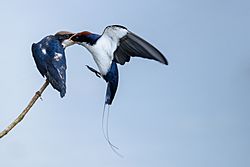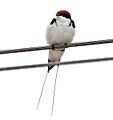Swallow facts for kids
Quick facts for kids Swallows |
|
|---|---|
 |
|
| Red-rumped Swallow | |
| Scientific classification | |
| Kingdom: | |
| Phylum: | |
| Class: | |
| Order: | |
| Suborder: | |
| Family: |
Hirundinidae
Vigors, 1825
|
The swallows and martins are a group of passerine birds in the family Hirundinidae which are characterised by their adaptation to aerial feeding. Swallow is used colloquially in Europe as a synonym for the Barn Swallow.
Within the swallow, the name "martin" tends to be used for the squarer-tailed species, and the name "swallow" for the more fork-tailed species; however, there is no scientific distinction between these two groups. The family contains around 83 species in 19 genera.
Contents
Description
The Hirundinidae have an evolutionarily conservative body shape which is similar across the clade but is unlike that of other passerines. Swallows have adapted to hunting insects on the wing by developing a slender, streamlined body and long pointed wings, which allow great maneuverability and endurance, as well as frequent periods of gliding. Their body shape allows for very efficient flight; the metabolic rate of swallows in flight is 49–72% lower than equivalent passerines of the same size.
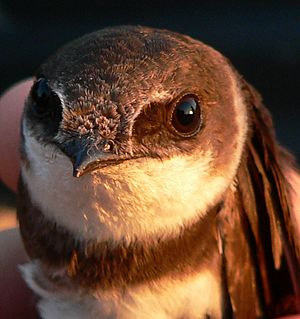
Swallows have two foveae in each eye, giving them sharp lateral and frontal vision to help track prey. They also have relatively long eyes, with their length almost equaling their width. The long eyes allow for an increase in visual acuity without competing with the brain for space inside of the head. The morphology of the eye in swallows is similar to that of a raptor.
Like the unrelated swifts and nightjars, which hunt in a similar way, they have short bills, but strong jaws and a wide gape. Their body length ranges from about 10–24 cm (3.9–9.4 in) and their weight from about 10–60 g (0.35–2.12 oz). The wings are long, pointed, and have nine primary feathers. The tail has 12 feathers and may be deeply forked, somewhat indented, or square-ended. A long tail increases maneuverability, and may also function as a sexual adornment, since the tail is frequently longer in males. In barn swallows the tail of the male is 18% longer than those of the female, and females will select mates on the basis of tail length.
The legs are short, and their feet are adapted for perching rather than walking, as the front toes are partially joined at the base. Swallows are capable of walking and even running, but they do so with a shuffling, waddling gait. The leg muscles of the river martins (Pseudochelidon) are stronger and more robust than those of other swallows. The river martins have other characteristics that separate them from the other swallows. The structure of the syrinx is substantially different between the two subfamilies; and in most swallows the bill, legs and feet are dark brown or black, but in the river martins the bill is orange-red and the legs and feet are pink.
The most common hirundine plumage is glossy dark blue or green above and plain or streaked underparts, often white or rufous. Species which burrow or live in dry or mountainous areas are often matte brown above (e.g. sand martin and crag martin). The sexes show limited or no sexual dimorphism, with longer outer tail feathers in the adult male probably being the most common distinction.
The chicks hatch naked and with closed eyes. Fledged juveniles usually appear as duller versions of the adult.
Distribution and habitat
The family has a worldwide cosmopolitan distribution, breeding on every continent except Antarctica. One species, the Pacific swallow, occurs as a breeding bird on a number of oceanic islands in the Pacific Ocean, the Mascarene martin breeds on Reunion and Mauritius in the Indian Ocean, and a number of migratory species are common vagrants to other isolated islands and even to some sub-Antarctic islands and Antarctica. Many species have enormous worldwide ranges, particularly the barn swallow, which breeds over most of the Northern Hemisphere and winters over most of the Southern Hemisphere.
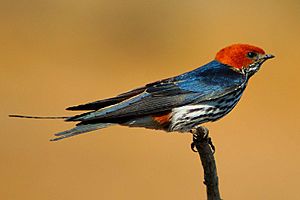
The family uses a wide range of habitats. They are dependent on flying insects and as these are common over waterways and lakes they will frequently feed over these, but they can be found in any open habitat including grasslands, open woodland, savanna, marshes, mangroves and scrubland, from sea level to high alpine areas. Many species inhabit human-altered landscapes including agricultural land and even urban areas. Land use changes have also caused some species to expand their range, most impressively the welcome swallow which began to colonise New Zealand in the 1920s, started breeding in the 1950s and is now a common landbird there.
Species breeding in temperate regions migrate during the winter when their insect prey populations collapse. Species breeding in more tropical areas are often more sedentary, although several tropical species are partial migrants or make shorter migrations. In antiquity it was thought that swallows hibernated in a state of torpor, even that they withdrew for the winter under water. Aristotle ascribed hibernation not only to swallows, but also to storks and kites. Hibernation of swallows was considered a possibility even by as acute an observer as Rev. Gilbert White, in his The Natural History and Antiquities of Selborne (1789, based on decades of observations). This idea may have been supported by the habit of some species to roost in some numbers in dovecotes, nests and other forms of shelter during harsh weather, and some species even entering torpor. There were several reports of suspected torpor in swallows from 1947, such as a 1970 report that white-backed swallows in Australia may conserve energy this way, but the first confirmed study that they or any passerine entered torpor was a 1988 study on house martins.
Behaviour and ecology
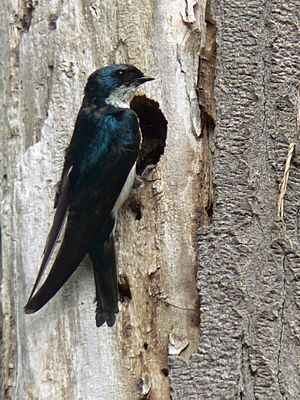
Swallows are excellent flyers, and use these skills to feed and attract a mate. Some species, like the mangrove swallow, are territorial, whereas others are not and simply defend their nesting site. In general, the males select a nest site, and then attract a female using song and flight, and (dependent on the species) guard their territory. The size of the territory varies depending on the species of swallow; in colonial-nesting species it tends to be small, but it may be much larger for solitary nesters. Outside the breeding season, some species may form large flocks, and species may also roost communally. This is thought to provide protection from predators such as sparrowhawks and hobbies. These roosts can be enormous; one winter roosting site of barn swallows in Nigeria attracted 1.5 million individuals. Non-social species do not form flocks, but recently fledged chicks may remain with their parents for a while after the breeding season. If a human being gets too close to their territory, swallows will attack them within the perimeter of the nest. Colonial species may mob predators and humans that are too close to the colony.
Diet and feeding
For the most part swallows are insectivorous, taking flying insects on the wing. Across the whole family a wide range of insects are taken from most insect groups, but the composition of any one prey type in the diet varies by species and with the time of year. Individual species may be selective; they do not scoop up every insect around them, but instead select larger prey items than would be expected by random sampling. In addition the ease of capture of different insect types affects their rate of predation by swallows. They also avoid certain prey types; in particular stinging insects such as bees and wasps are generally avoided. In addition to insect prey a number of species will occasionally consume fruits and other plant matter. Species in Africa have been recorded eating the seeds of Acacia trees, and these are even fed to the young of the greater striped swallow.
The swallows generally forage for prey that is on the wing, but they will on occasion snap prey off branches or on the ground. The flight may be fast and involve a rapid succession of turns and banks when actively chasing fast moving prey; less agile prey may be caught with a slower more leisurely flight that includes flying in circles and bursts of flapping mixed with gliding. Where several species of swallow feed together they will be separated into different niches based on height off the ground, some species feeding closer to the ground and others feeding at higher levels. Similar separation occurs where feeding overlaps with swifts. Niche separation may also occur with the size of prey chosen.
Breeding
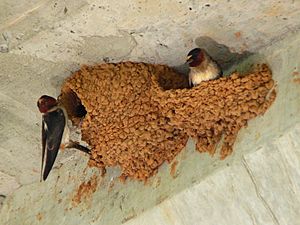
The more primitive species nest in existing cavities, for example in an old woodpecker nest, while other species excavate burrows in soft substrate such as sand banks. Swallows in the genera Hirundo, Ptyonoproggne, Cecropis, Petrochelidon and Delichon build mud nests close to overhead shelter in locations that are protected from both the weather and predators. The mud-nesters are most common in the Old World, particularly Africa, whereas cavity-nesters are the rule in the New World. Mud nesting species in particular are limited in areas of high humidity, which causes the mud nests to crumble. Many cave, bank and cliff dwelling species of swallow nest in large colonies. Mud nests are constructed by both males and females, and amongst the tunnel diggers the excavation duties are shared as well. In historical times, the introduction of man-made stone structures such as barns and bridges, together with forest clearance, has led to an abundance of colony sites around the globe, significantly increasing the breeding ranges of some species. Birds living in large colonies typically have to contend with both ectoparasites and conspecific nest parasitism. In barn swallows, old mated males and young unmated males benefit from colonial behaviour, whereas it is likely that females and mated young males benefit more from nesting by themselves.
Pairs of mated swallows are monogamous, and pairs of non-migratory species often stay near their breeding area all year, though the nest site is defended most vigorously during the breeding season. Migratory species often return to the same breeding area each year, and may select the same nest site if they were previously successful in that location. First-year breeders generally select a nesting site close to where they were born and raised. The breeding of temperate species is seasonal, whereas that of subtropical or tropical species can either be continuous throughout the year or seasonal. Seasonal species in the subtropics or tropics are usually timed to coincide with the peaks in insect activity, which is usually the wet season, but some species like the white-bibbed swallow nest in the dry season to avoid flooding in their riverbank nesting habitat. All swallows will defend their nests from egg predators, although solitary species are more aggressive towards predators than colonial species. Overall the contribution of male swallows towards parental care is the highest of any passerine bird.
The eggs of swallows tend to be white, although those of some mud-nesters are speckled. The average clutch size is around four to five eggs in temperate areas and two to three eggs in the tropics. The incubation duties are shared in some species, in others the eggs are incubated solely by the females. Amongst the species where the male helps with incubation the contribution varies amongst species, with some species like the cliff swallow sharing the duties equally and the female doing most of the work in others. Amongst the barn swallows the male of the American subspecies helps (to a small extent) whereas the European subspecies does not. Even in species where the male does not incubate the eggs the male may sit on them when the female is away to reduce heat loss (this is different from incubation as that involves warming the eggs, not just stopping heat loss). Incubation stints last for 5–15 minutes and are followed by bursts of feeding activity. From laying, swallow eggs take between 10–21 days to hatch, with 14–18 days being more typical.
The chicks of swallows hatch naked, generally with only a few tufts of down. The eyes are closed and do not fully open for up to 10 days. The feathers take a few days to begin to sprout, and the chicks are brooded by the parents until they are able to thermoregulate. On the whole they develop slowly compared to other passerine birds. The parents do not usually feed the chicks individual insects but instead a bolus of food comprising ten to a hundred insects. Regardless of whether the species has males that incubate or brood the chicks, the males of all hirundines will help feed the chicks. It is difficult to judge when the young fledge, as they will be enticed out of the nest after three weeks by parents but frequently return to the nest afterwards in order to roost.
Images for kids
-
The Bahama swallow is listed as an endangered species
-
An artificial purple martin nesting colony
-
Wire-tailed swallow, Hirundo smithii
See also
 In Spanish: Hirundínidos para niños
In Spanish: Hirundínidos para niños



